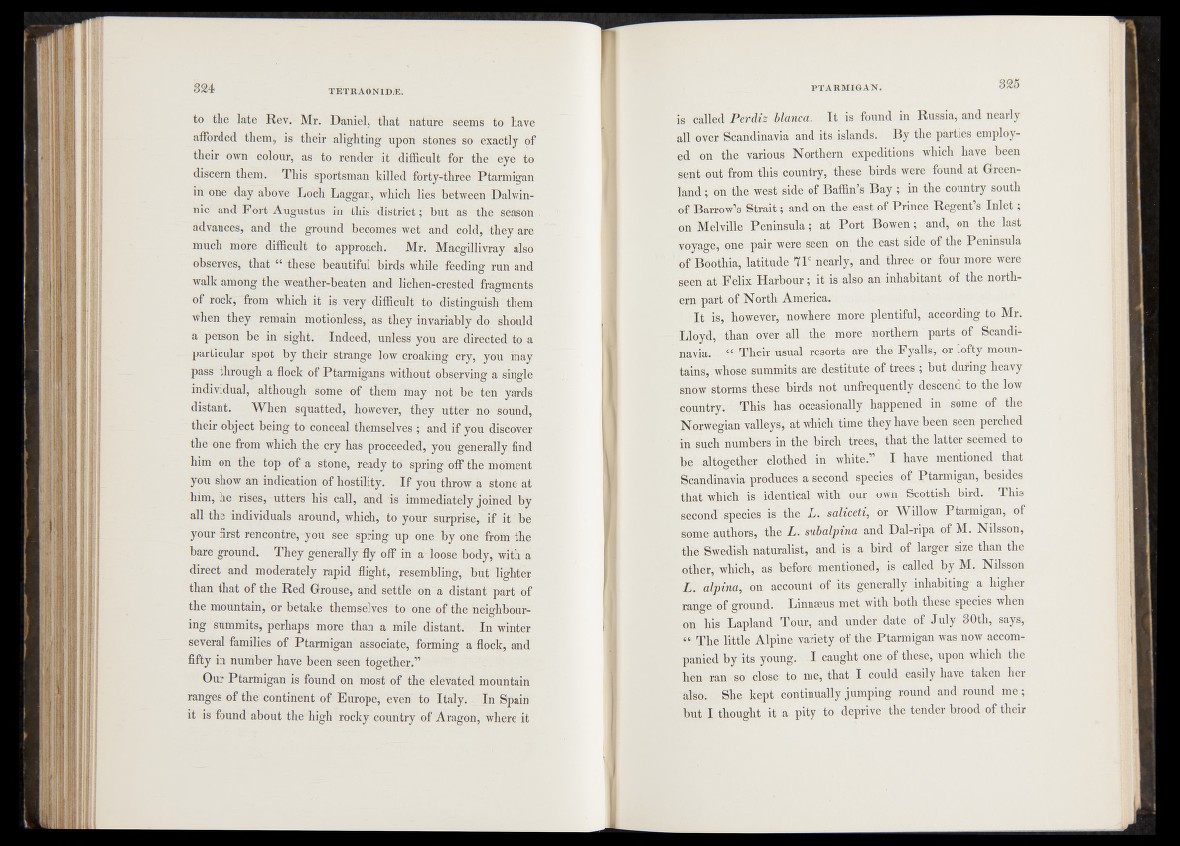
to the late Rev. Mr. Daniel, that nature seems to have
afforded them, is their alighting upon stones so exactly of
their own colour, as to render it difficult for the eye to
discern them. This sportsman, hilled forty-three Ptarmigan
in one day above Loch Laggan, which liés between Dalwin-
nie and F ort Augustus 'in this '‘district ; but as -the season
advances, and the ground becomes wet and cold, they are
much more difficult to approach. Mr. Mâcgillivrayf'Ëlsd
observes, that “ these beautiful birds while feeding run and
walk among the weather-beaten and lichen-crested fragments
of rock, from which it is. very difficult to distinguish them
when they remain motionless- as they invariably do should
a person be- in sight. Indeed, unless-you âre directed t© a
particular spot by their strange low croaking cry, you may
pass through a flock of Ptarmigans without observing a single
individual, although some of them may not . bê ten yards
distant. When squatted, -however, they litter’" ho-' ;Sound^
their object being to conceal themselves^ and if you discover
the one from which the cry has proceeded, you generally, find
him on the top of a stone, ready to" spring off the moment
you show an indication of hostility. I f you throw à stone %t
him, he rises, -uttdrs'his call, and i s ’ immediately joined by
all the individuals around, which, to your surpris^ I f^ F b e
your first rencontre,-you sëê spring up ohé" by one from, the
bare ground. They generally fly off in a loose body, with a
direct and moderately rapid flight, ‘'resembling, bùfTightÿr
than that of the Red Grouse* and settle on a distant part of
the mountain, or betake themselves to one .of the neighbour-
ing summits, perhaps more than a mile distant. In winter
several families of Ptarmigan associate, forming a flock, and
fifty in number have been seen together.”
Our Ptarmigan is found on most of the elevated mountain
ranges of the continent of Europe, even to Italy. In Spain
it is found about the high rocky country of Aragon; where it
is called P e rd iz : blanca. It . is found in Russia, and nearly
all over Scandinavia and its islands. By the parties employed
on the various Northern expeditions which have been
sent out from this country, these birds were found at Greenland
; on the-west side of Baffin’s Bay ; in the country south
of Bartow’s Strait.; and on the east of Prince Regent s In le t;
on Melville Peninsula; at Port Bowen; and, on the last
Voyage, one pair were'seen otu>|he east side of the Peninsula
of 'Boothia, latitude 71° nearly, and three or four more were
seen at Felix Harbour; itd&m,Md|an inhabitant of the northern
part of .North America.
It'-is, however; nowhere affii g plentifiil, according to Mr.
Lloyd, -.than <pef,' all the more ^orthenT parts of Scandinavia,
x «'Their usual resorts, are the Fyalls, or lofty mountains,.
whose summits are .'destitute, of trees ; but during heavy
snow storms these birds not unfrequently descend to the low
-edunfcry. This has occasionally happened, in someftbf the
Norwegian valley sj, at which time they have been seen perched
ickfacfrnumbers in th e birch.trees, that the latter seemed*to
be altogether clothed in* white.'”. I have mentioned that
Scandinavia produces a second species -of,Ptarmigan, besides
that which is identical with our own Scottish bird. This
second' species, is the L . saliceti, or Willow Ptarmigan, of
some-authors,., the L . subalpina and Dal-ripa of M. Nilsson,
the Swedish naturalist, and is.,a bird ;of larger size than the
other, which, as before^mentioned, ^ called by M. Nilsson
L. alpim, on account bfcits generally inhabiting a higher
range onground. . Linnseug met .with'both these species when
on his Lapland Tour, and under date of July 30th, says,
“ »The little Alpine variety of the Ptarmigan was now accompanied
by it s young. I caught one of these, upon which the
hen ran • soi close' to me, that I could easily have taken her
afso.:. She kept continually jumping round and round me;
but I thought it a pity to deprive the tender brood of their